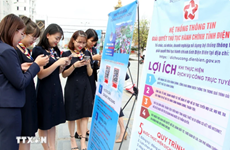Local investment in science shows sign of prosperity
Disbursement for local scientific development last year prospered
remarkably, with effective use of both public and private funds, the
Vietnam Economic News (VEN) reported on February 17.
Disbursement for local scientific development last year prospered
remarkably, with effective use of both public and private funds, the
Vietnam Economic News (VEN) reported on February 17.
Last year’s total local science and technology development funding reached 1.919 trillion VND (90 million USD), with many provinces across the country surpassing the annual funding plans including Ca Mau (272 percent) and Tuyen Quang (159 percent), the paper quoted Ho Ngoc Luat, Director of the Department of Local Science and Technology Development under the Ministry of Science and Technology, as saying.
Most local science and technology development funds were used for research and development activities and State operation management of the science and technology.
Cities and provinces across the country have deployed 1,324 missions, of which, 36 percent for agricultural sciences, 30 percent for social sciences and humanities, 19 percent for supporting businesses to improve productivity and product quality, 12 percent for medical and pharmaceutical sector, and 3 percent for the natural sciences.
Notably, most missions have been ordered to implement; and therefore, the number of applied research results and technical advances increased significantly, reaching approximately 70 percent of all research subjects.
Thai Binh province conducted 201 tests of new rice varieties and has identified a number of promising ones like BG6, RVT11, TBR27, and HYT108 with productivity from 7-7.5 tonnes per ha, high resistance to pests, and high quality.
Khanh Hoa province has perfected the snout otter breeding process and will provide the around 200 million snout otter clam seeds per year.
Quang Ngai province has applied advanced techniques to build a 600ha hilly land grown sugarcane model yielding up to 90 tonnes per ha.
Apart from State funding, many provinces and cities have established specific mechanisms and policies to create favorable conditions to attract private funding sources.
Statistics showed that provincial missions received 81 percent State funding and 19 percent private funding; district-level missions received 43 percent state funding and 57 percent private funding.
“This is a new feature in science and technology development funding,” Luat said.
According to him, there are still some localities that have not disbursed 100 percent science and technology development funding yet and wrongly used that amounts. For example, Vinh Phuc used the science and technology investment funds for construction of waste water treatment systems in local residential quarters; and Nghe An used the funds to carry out the services for granted land use right certificates to local organisations.
Investment funding for scientific and technological activities is generally low on annual average, with provincial disbursement of 10 billion VND for annual implementation of scientific and technological projects.
According to Director of Lam Dong’s Department of Science and Technology Le Xuan Tham, due to provincial difficulties in funding scientific and technological activities, the province have not attracted leading scientists in the field of high technology and biotechnology, as well as intensively invested infrastructure investment.
In addition, the financial regime for science and technology spending has failed to create a favorable environment to attract scientists and encourage scientific and technological institutions inside and outside the province to participate in local scientific and technological research and development activities.-VNA
Last year’s total local science and technology development funding reached 1.919 trillion VND (90 million USD), with many provinces across the country surpassing the annual funding plans including Ca Mau (272 percent) and Tuyen Quang (159 percent), the paper quoted Ho Ngoc Luat, Director of the Department of Local Science and Technology Development under the Ministry of Science and Technology, as saying.
Most local science and technology development funds were used for research and development activities and State operation management of the science and technology.
Cities and provinces across the country have deployed 1,324 missions, of which, 36 percent for agricultural sciences, 30 percent for social sciences and humanities, 19 percent for supporting businesses to improve productivity and product quality, 12 percent for medical and pharmaceutical sector, and 3 percent for the natural sciences.
Notably, most missions have been ordered to implement; and therefore, the number of applied research results and technical advances increased significantly, reaching approximately 70 percent of all research subjects.
Thai Binh province conducted 201 tests of new rice varieties and has identified a number of promising ones like BG6, RVT11, TBR27, and HYT108 with productivity from 7-7.5 tonnes per ha, high resistance to pests, and high quality.
Khanh Hoa province has perfected the snout otter breeding process and will provide the around 200 million snout otter clam seeds per year.
Quang Ngai province has applied advanced techniques to build a 600ha hilly land grown sugarcane model yielding up to 90 tonnes per ha.
Apart from State funding, many provinces and cities have established specific mechanisms and policies to create favorable conditions to attract private funding sources.
Statistics showed that provincial missions received 81 percent State funding and 19 percent private funding; district-level missions received 43 percent state funding and 57 percent private funding.
“This is a new feature in science and technology development funding,” Luat said.
According to him, there are still some localities that have not disbursed 100 percent science and technology development funding yet and wrongly used that amounts. For example, Vinh Phuc used the science and technology investment funds for construction of waste water treatment systems in local residential quarters; and Nghe An used the funds to carry out the services for granted land use right certificates to local organisations.
Investment funding for scientific and technological activities is generally low on annual average, with provincial disbursement of 10 billion VND for annual implementation of scientific and technological projects.
According to Director of Lam Dong’s Department of Science and Technology Le Xuan Tham, due to provincial difficulties in funding scientific and technological activities, the province have not attracted leading scientists in the field of high technology and biotechnology, as well as intensively invested infrastructure investment.
In addition, the financial regime for science and technology spending has failed to create a favorable environment to attract scientists and encourage scientific and technological institutions inside and outside the province to participate in local scientific and technological research and development activities.-VNA













